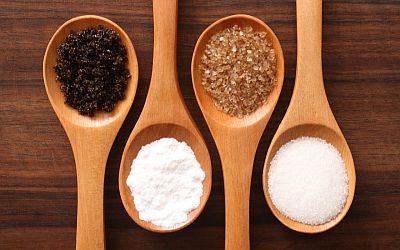
Sugar means a lot of things in our culture, ranging from ideal children (Sugar and spice, and everything nice) to easing unpleasant situations (A spoonful of sugar) to sexual desire (Pour some sugar on me/ ooh, in the name of love ). Sugar hardly ever means a bad thing in pop culture. But, when it comes to our health, its a different story.
In 2008, Americans consumed 20 million short tons (40 billion pounds) of caloric sweeteners, according to the U.S. Department of Agriculture (USDA). With four calories per gram, the weight adds up in American waistlines. In recent years, sugar has been implicated as a major factor in epidemic diseases such as obesity and diabetes. It also has a bad rap for causing tooth decay.
Excess dietary sugar and unstable insulin levels are among the leading causes of disease and health challenges in the United States, including the rising epidemics of diabetes and obesity, and both food manufacturers and consumers are becoming more aware of this and responding, said Wes Crain, vice president, Navitas Naturals. He added, Food shoppers are reading product labels more than ever to see how their foods are sweetened, so food manufacturers want to have a more attractive natural ingredient list.
Colleen M. Zammer, market development manager, health and nutrition, Jungbunzlauer Inc., attributes the growth of the natural sweetener industry to three factors: 1) The struggle with obesity and the need to reduce calories in foods and beverages, with a major target being sugar calories; 2) Sporadic studies or published comments questioning the safety of artificial sweeteners, which have been a longtime solution for reducing sugar calories; and 3) The opportunity to cater to niche markets that are high value and high profit using unique natural sweeteners that combine safety, good taste and a natural aura."
However, there are those on both sides of the fence: those who say sucrose is evil, and those who say it is carrying the blame that should be attributed to the overall lifestyle trend of added calories and reduced activity. In fact, Audrae Erickson, president, Corn Refiners Association, noted people often forget glucose provides energy to the body and is a necessary carbohydrate for brain function.
Highly Natural?
Further, Erickson pointed out much-maligned nutritive sweeteners, such as high-fructose corn syrup (HFCS) are safe and natural. FDA feels the same way, as a 2008 letter from them to the Corn Refiners Association said it does not object to use of the term natural on a product containing HFCS because natural means nothing artificial (including artificial flavors) or synthetic (including all color additives regardless of source) has been included in or has been added to a food that would not normally be expected to be in the food.
The Corn Refiners Association, which represents the corn wet milling industry, has faced an uphill battle trying to remove the scorn attached to HFCS, which they say is undeserved. Erickson noted HFCS has the same caloric value as sucrose (aka table sugar), honey, fruit juice concentrate, agave nectar and cane sugar. And, HFCS offers great benefits to product manufacturers, she said. Because of its viscosity, it lends thickness to products, and it also keeps ingredients evenly mixed in salad dressings, jams, jellies and sauces. Its a highly prized ingredient in a vast array of beverage and food applications. It bakes well, it freezes well, and it sits on the shelf well in product applications. She added HFCS comes at lower cost than sucrose, honey and agave.
Studies have found the body reacts to HFCS and sucrose the same metabolically,1 and they both raise triacylglycerols the same amount.2 In 2008, the American Dietetic Association released a statement that said HFCS is nutritionally equivalent to sucrose. Both sweeteners contain the same number of calories and consist of about equal parts of fructose and glucose. Once absorbed into the blood stream, the two sweeteners are indistinguishable.
Still, HFCS has been the newest ingredient to avoid with many products touting high-fructose corn syrup free, and many shoppers passing on products that contain HFCS. John White, Ph.D., president of White Chemical Research, a consulting firm to the food and beverage industry, said the trouble for HFCS started with a 2004 paper published in the Journal of Clinical Nutrition that developed the hypothesis that HFCS was responsible for obesity.3 The researchers looked at the use of HFCS and obesity rates and found a correlation. Unfortunately, there is a tendency in human nature to accept as fact things that we read, White said. People didnt read it, as heres an interesting hypothesis, they read it as here is an interesting fact: HFCS is responsible for obesity.
White warned against formulators replacing HFCS in products with other nutritive sweeteners. There is a lot of pressure to formulate away from HFCS. However, food manufacturers should reformulate for the right reason. If they are reformulating to change the nutritional value of the food, reformulating from HFCS to sucrose will not change the nutritional value of the food. There are those who take HFCS out and replace it with evaporated cane juice, which is a fancy name for sugar, yet there is no nutritional gain for doing so. It looks better on the label, but its misleading to consumers. If they are looking for a nutritional improvement, they get none.
Naturally Nutritives
However, it seems consumers have jumped on the HFCS-free bandwagon, as Peter Sokoloski, general manager, HealthCo, noted along with reducing calorie consumptions and eating an organic diet, consumers, and therefore manufacturers, are driven by a need to eliminate HFCS in the diet.
One such sweetener sugar affecting the natural market is palm sugar, which is lower on the glycemic index (GI) than sucrosethe lower the GI, the smaller the fluctuations in blood glucose and insulin levels. Eating foods lower in GI can lead to reduced risk of heart disease and diabetes, and is a key to sustainable weight loss, according to Sydney University Glycemic Index Research Service (SUGiRS). Sucrose has a GI of 68, honey has 55, agave has 42, while palm sugars GI sits at 35. Crain noted Navitas Naturals Sweet Tooth Organic Palm Sugar is high in amino acids, potassium, magnesium, zinc and iron, and is a good natural source of B vitamins
Navitas Naturals also offers Yacon (Smallanthus sonchifolius), with a much lower GI at about 1, which gets its sweet taste from fructooligosaccharides (FOS). FOS is a mixture of glucose-terminated fructose chains that contains fiber, and is considered a prebiotic. Yacon also contains inulin, which has been shown to increase calcium absorption,4 and is also a prebiotic. Yacon offers about half the calories of honey and research shows it offers additional health benefits. Study have showed yacon can reduce oxidative stress,5 may help prevent and treat chronic diseases involving oxidative stress, particularly diabetes.6 It did not increase hypoglycemic activity in rats and significantly reduced serum triacylglycerol levels.7 On the human side, yacon syrup produced a significant decrease in body weight, waist circumference and body mass index (BMI) in obese and slightly dyslipidemic pre-menopausal women.8 Additionally, a decrease in fasting serum insulin was observed as well as an increase in defecation frequency and satiety sensation. Fasting glucose and serum lipids were not affected and a positive effect was found in serum low-density lipoprotein (LDL) cholesterol levels.
In addition, It is an excellent source of nutrients, including bioavailable protein, potassium, vitamins A and C, calcium, iron and phosphorus, as well as fiber, Cain said. Yacon is also an excellent source of antioxidants and is known to help strengthen the immune system.
Lucuma powder is naturally sweet, but also low on the glycemic index. Navitas Naturals Lucuma Powder is high in iron, zinc, potassium, calcium, magnesium and vitamin B3, and it is a great source of beta carotene, fiber and bioavailable protein, Cain noted.
Steviaa Sweet Sensation
If manufacturers are looking for a way to add sweetness to products without adding calories or a glycemic load, they may look to one of the biggest ingredients to hit the sweetener market in the past decade: stevia. Since stevia (Stevia rebaudiana), which can be 300-times sweeter than sugar, was affirmed generally recognized as safe (GRAS) by several firms in 2008, its popularity is has risen dramatically.
The issuance of GRAS designations for stevia resulted in an explosion of possibilities for this natural sweetener in the marketplace, Sokoloski said. Stevia has long been sold in the United States as an herbal dietary supplement rather than as a sweetener. In the past couple of years, that has changed and many companies are furiously looking at how to use this new sweetener in foods and beverages.
Stevia can be a sweet deal for those looking to reduce blood pressure. A Chinese study found 500 mg/d of stevioside power decreased systolic and diastolic blood pressure blood pressure compared to placebo after two years.9 Similar results have been found in rats.10 In type 2 diabetic patients, stevia reduced postprandial blood glucose levels, indicating beneficial effects on the glucose metabolism.11
This small, green plant can also be friendly for formulations. Jason Hecker, vice president global marketing, PureCircle Limited, said its Reb A ingredient offers high solubility, is suitable for cooking because it is heat stable, is pH stable, does not ferment, offers a long shelf life, and is photo stable
However, Stevia is not problem-free for formulators, as noted by Jim May, president and founder of Wisdom Natural Brands. Many manufacturers are finding stevia alters the taste of their product. An entire industry of making masking agents has evolved for stevia. He added Wisdom eliminates this problem with its stevia ingredients by extracting with purified water instead of chemicals and alcohols.
The true reason stevia, and all other sweeteners, show up in finished goods is the taste; and if that taste is off or different from the last batch, consumers may switch to other products. This is why manufacturers must be diligent to ensure consistency. In the case of the more exotic organic sweeteners we source, the primary challenge is to initiate and maintain a consistent supply that tastes the same every time, Cain noted, adding Navitas Natruals also offers a, Green Stevia powder. In addition to finding the right farming and supply partners, it is a delicate balance to get the low temperature processing just right to maximize the favorable natural flavors and negate any potential off-flavors.
To combat this taste issue, Jessica Jones-Dille, senior manager, Industry Trends and Market Research, WILD Flavors Inc., said WILD offers an array of taste modification solutions for its portfolio of Sunwin Stevia products. These systems address mouthfeel, masking, sweet enhancement and blocking of bitterness that improve the taste profile of foods and beverages containing Stevia, she said.
For HealthCo, stevias taste profile is improved with enzymes. Enzyme-treated Stevia FSE provides a better-rounded sweetening profile that is ideal for numerous food applications, Sokoloski said. Stevia FSE utilizes the whole stevia leaf and is not an isolated fraction, like Reb A, which is said to require additional added substances to mask the bitter aftertaste. No flavorings or masking agents are used in Stevia FSE because none are needed. The natural enzyme treatment enhances its organoleptic (sensory) properties.
Still, these taste issues can drive manufacturers away from stevia entirely, just like it did for Catherine Wilbert, N.D., Ph.D., chief innovation officer, Wellness Innovations. After about a year of trying to use stevia,we abandoned the whole idea, she said, explaining, No matter what you do to stevia, it still has an aftertaste and it changes over time; it cant quite be standardized. It was hard to get consistency and mask the aftertaste. When you have pure stevia with stevioside and rebaudioside, they fall off at different times, so you have different sweetness and bitter notes happening over the aging of the product.
Engaging Erythritol
Wilberts answer was turning to another no-calorie, no-GI-load sweetener for its Swerve line of sweeteners. Erythritol occurs naturally in various fruits and fermented foods, and it contains 0.2 calories per gram, which is typically rounded to zero calories on product labels. It does not affect mean plasma glucose or insulin levels,12 and it has been shown to offers protection against tooth decay.13
Swerve is an erythritol-based sweetener, with about five other ingredients, that looks, measures, tastes, bakes, candies, freezes just like sugar, Wilbert said. It is a one-to-one granular product, which makes it remarkable and easy to reformulate products. Its a blend of oligosaccharides that literally makes the erythritol act like sugar.
Zammer said erythritol is different from high-intensity sweeteners in that it has a bulk density similar to sugar, so it can provide bulk in packaging and manufacturing as well as bulk functionality in formulations. This means other bulking agents are not required. It also provides a full mouthfeel similar to sugar, which is often lacking in high-intensity sweeteners. Erythritol also has a higher digestive tolerance than other polyols and is non-cariogenic. She added erythritol is stable in manufacturing and processing, and has a negative heat of solution, which results in a cooling effect while it is dissolved in liquids. This effect dissipates upon complete dissolution, and is not an issue in beverages, but in low moisture systems such as confections, it can contribute to the flavor experience of the product.
The Bitter with the Sweet
Besides for taste, sweeteners can pose potential formulation challenges, including temperature, quality control, moisture and supply issues. Noted Cain, For the products that are low-temperature processed, keeping them in as raw a state as possible is challenging. It is important to closely monitor the production to maintain these low temperatures. With raw and organic products, it is also important to continually test for microbes, and to store and handle the products with great care.
Wilbert said, Erythritol is awesome, but it has an odd cooling effect. It dries products out, so we had to figure out how to add [moisture] back in. Another one of Wellnesss biggest challenges is making sure it always has abundant raw material. With more people coming into the market, obviously, the raw materials become scarcer. With Coca-Cola and Pepsi starting to use erythritol, we had to make sure we secured the ability to have the supply we need.
Sweet-Tempered Future
Hopefully, that supply will last long into the future, as many in the industry expect future growth for the natural sweetener market. The future is bright for natural sweeteners as more people are reading labels and keeping track of the substances they consume, Cain predicted. People will always enjoy sweet-tasting foods, but they also now want the peace of mind provided by better-for-you sweeteners.
Wilbert agreed, adding The days of the blue, the pink, and the yellow as table-top sweeteners are long gone . Theres going to be a lot more players in the market; there wont be as few big players, but theres going to be a lot more options.
And, with the food and beverage market headed in the direction of natural and healthier options in general, sweeteners will play an instrumental role in this shift, according to Hecker. Alarming health trends regarding obesity and diabetes are the focus of consumers, government, interest groups and manufacturers alike. As a result, manufacturers are actively looking for natural ways to provide better options with calorie reduction as one important part of the solution. Natural, zero-calorie or reduced-calorie products can provide the solutions formulators are looking for and will play an increasingly important role in the sweetener category.
As long as consumers still sing, Sugarpie honeybunch/You know that I'm weak for you/I can't help myself, but still face the dilemma of obesity and diabetes, the market for natural sweeteners will exist. By meeting formulation challenges presented by alternatives that not only sweeten foods and beverages, but also include their own health benefits, product manufacturers are sure to secure sweet sales.
References for As Sweetor Even Sweeter ThanSugar
1. Melanson KJ, et al. Effects of high-fructose corn syrup and sucrose consumption on circulating glucose, insulin, leptin, and ghrelin and on appetite in normal-weight women. Nutrition. 2007 Feb;23(2):103-12.
2. Stanhope KL, et al. Twenty-four-hour endocrine and metabolic profiles following consumption of high-fructose corn syrup-, sucrose-, fructose-, and glucose-sweetened beverages with meals. Am J Clin Nutr. 2008 May;87(5):1194-203.
3. Bray GA, Nielsen SJ, Popkin BM. Consumption of high-fructose corn syrup in beverages may play a role in the epidemic of obesity. Am J Clin Nutr. 2004 Apr;79(4):537-43.
4. Abrams SA, et al. A combination of prebiotic short- and long-chain inulin-type fructans enhances calcium absorption and bone mineralization in young adolescents. Am J Clin Nutr. 2005 Aug;82(2):471-6.
5. Valentová K, Sersen F, Ulrichová J. Radical scavenging and anti-lipoperoxidative activities of Smallanthus sonchifolius leaf extracts. J Agric Food Chem. 2005 Jul 13;53(14):5577-82.
6. Valentová K, et al. The effect of Smallanthus sonchifolius leaf extracts on rat hepatic metabolism. Cell Biol Toxicol. 2004 Mar;20(2):109-20.
7. Genta SB, et al. Subchronic 4-month oral toxicity study of dried Smallanthus sonchifolius (yacon) roots as a diet supplement in rats. Food Chem Toxicol. 2005 Nov;43(11):1657-65.
8. Genta S., et al. Yacon syrup: Beneficial effects on obesity and insulin resistance in humans. Clin Nutr. 2009 Feb 28
9. Hsieh MH, et al. Efficacy and tolerability of oral stevioside in patients with mild essential hypertension: a two-year, randomized, placebo-controlled study. Clin Ther. 2003 Nov;25(11):2797-808.
10. Jeppesen PB, et al. Antihyperglycemic and blood pressure-reducing effects of stevioside in the diabetic Goto-Kakizaki rat Metabolism. 2003 Mar;52(3):372-8.
11. Gregersen S, et al. Antihyperglycemic effects of stevioside in type 2 diabetic subjects Metabolism. 2004 Jan;53(1):73-6.
12. F. Bornet, et. al. Erythritol: A Review of Biological and Toxicological Studies Regul Toxicol Pharmacol 1996; 24, S296S302
13. K.K. Mäkinen, et al. Similarity of the Effects ofErythritol and Xylitol on SomeRisk Factors of Dental Caries Caries Res 2005;39:207-215
About the Author(s)
You May Also Like






.png?width=800&auto=webp&quality=80&disable=upscale)